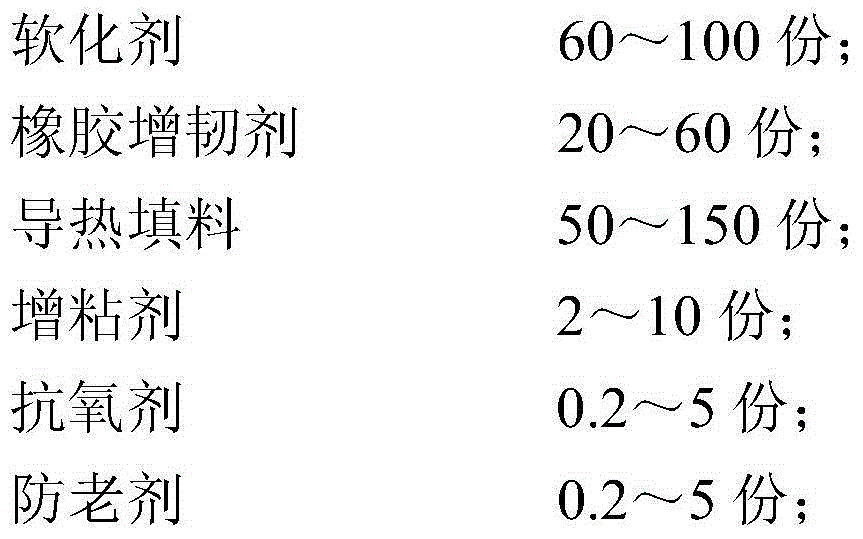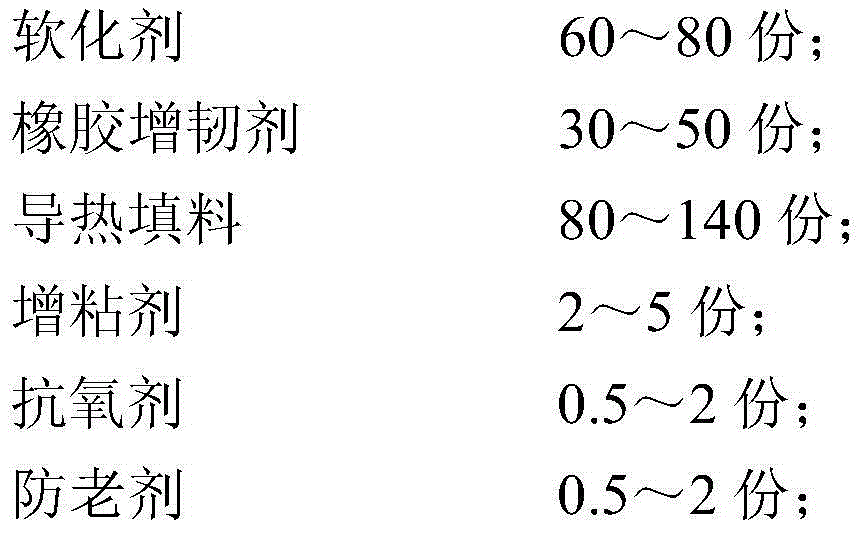Heat conducting adhesive and preparation method and application thereof
A technology of thermally conductive adhesives and thermally conductive fillers, applied in the direction of adhesive types, natural rubber adhesives, polymer adhesive additives, etc. and other problems, to achieve the effects of excellent processing performance and thermal conductivity, cost reduction, and high adhesion
- Summary
- Abstract
- Description
- Claims
- Application Information
AI Technical Summary
Problems solved by technology
Method used
Image
Examples
Embodiment 1
[0041] The thermally conductive adhesive contains the following components in parts by weight:
[0042]
[0043]
[0044] (1) After compounding graphite and carbon black, dry it at 150℃ for 2h to remove water and volatile solvent impurities to obtain a graphite / carbon black compound thermally conductive filler; then graphite / carbon black compound thermally conductive filler and oxidation Aluminium and ceramic powder are compounded to obtain a mixed thermal conductive filler containing graphite and carbon black;
[0045] (2) Roll the natural rubber on an open mill with a roller spacing of 3mm and a roll time of 10min; add part of the mixed thermally conductive filler prepared in step (1) to the polyisobutylene, stir evenly, and then apply to the open mill Above the gap between the two rollers of the machine, and keep an appropriate amount of accumulated glue;
[0046] (3) Coat antioxidant 168, tackifier rosin glyceride, and antioxidant RD on the top of the roller; then start heating,...
Embodiment 2
[0048] The thermally conductive adhesive contains the following components in parts by weight:
[0049]
[0050] (1) After the graphite / carbon black is compounded, dried at 200℃ for 1 hour to remove water and volatile solvent impurities to obtain a graphite / carbon black compound thermally conductive filler; then graphite / carbon black compound thermally conductive filler and oxidation Aluminium and ceramic powder are compounded to obtain a mixed thermal conductive filler containing graphite and carbon black;
[0051] (2) Roll the natural rubber on an open mill with a roller spacing of 7mm and a roll time of 20min; add part of the mixed thermally conductive filler prepared in step (1) to the polyisobutylene, stir evenly, and then apply to the open mill Above the gap between the two rollers of the machine, and keep an appropriate amount of accumulated glue;
[0052] (3) Coat antioxidant 264, tackifier C5 tackifying resin, and antioxidant DFC-34 on the top of the roller; then start heat...
Embodiment 3
[0054] The thermally conductive adhesive contains the following components in parts by weight:
[0055]
[0056] (1) After the graphite / carbon black is compounded, it is dried at 170℃ for 1.5 hours to remove water and volatile solvent impurities to obtain a graphite / carbon black compound thermally conductive filler; then graphite / carbon black compound thermally conductive filler and Zinc oxide and ceramic powder are compounded to obtain a mixed thermal conductive filler containing graphite and carbon black;
[0057] (2) The EPDM rubber is wrapped and rolled on an open mill with a roller spacing of 3mm and a wrapping time of 15min; part of the mixed thermally conductive filler prepared in step (1) is added to the polyisobutylene, stirred evenly, and then coated Go to the top of the gap between the two rollers of the mill, and keep a proper amount of accumulated glue;
[0058] (3) Coat antioxidant 1010, C5 tackifying resin, rosin glyceride, and antioxidant RD on the top of the roller;...
PUM
| Property | Measurement | Unit |
|---|---|---|
| particle diameter | aaaaa | aaaaa |
| particle diameter | aaaaa | aaaaa |
Abstract
Description
Claims
Application Information
 Login to View More
Login to View More - R&D
- Intellectual Property
- Life Sciences
- Materials
- Tech Scout
- Unparalleled Data Quality
- Higher Quality Content
- 60% Fewer Hallucinations
Browse by: Latest US Patents, China's latest patents, Technical Efficacy Thesaurus, Application Domain, Technology Topic, Popular Technical Reports.
© 2025 PatSnap. All rights reserved.Legal|Privacy policy|Modern Slavery Act Transparency Statement|Sitemap|About US| Contact US: help@patsnap.com



